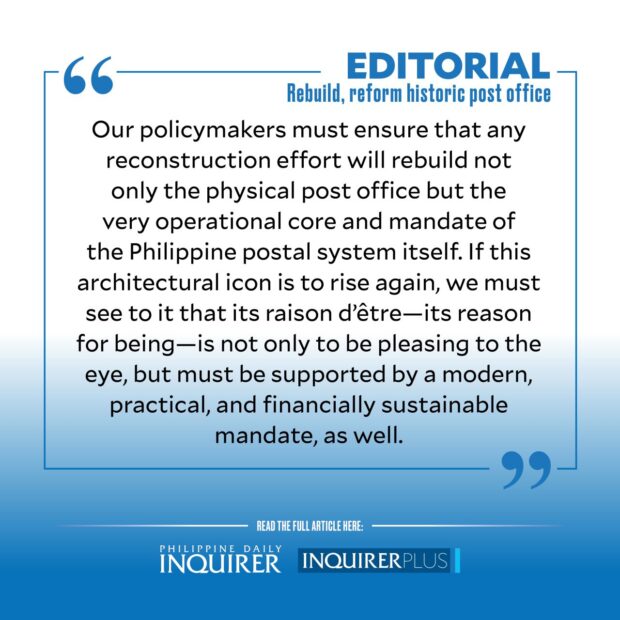Rebuild, reform historic post office
 The Manila Central Post Office building was destroyed along with much of the Philippine capital during World War II. But it was rebuilt soon after that, and the beautiful neoclassical structure went on to play a key role in serving the country’s vital communication needs for decades.
The Manila Central Post Office building was destroyed along with much of the Philippine capital during World War II. But it was rebuilt soon after that, and the beautiful neoclassical structure went on to play a key role in serving the country’s vital communication needs for decades.
In the same vein, the open square fronting it—first named Plaza Lawton, and then Liwasang Bonifacio—played a similar role in providing a platform for communicating to the nation and the rest of the world Filipinos’ quest for democracy alongside their fight against the many forms of injustice and inequality in society.
On Monday, the country awoke to heartrending images being shared over the internet by news outfits and eyewitnesses on the ground of the raging orange inferno that was consuming the historic building from the inside out.
Firefighters put the initial damage estimate at P300 million, but the final figure will certainly be higher by several multiples when factoring in the damage that fire can cause to concrete, especially by weakening the iron rebar inside them, to the point of rendering the structure unsafe for use without major rework. Also potentially incalculable is the value of the postal parcels and letters in transit destroyed by the ravaging flames. Even the loss of some Philippine national identification cards razed in the massive fire will cost some money and contribute to the prolonged delay in their delivery to the public.
Perhaps it is fitting that one of the earliest voices in government to speak of restoring the structure designed by Juan Arellano, Tomas Mapua, and Ralph Doane are those of Senate President Juan Miguel Zubiri and the Senate finance committee chair Sen. Juan Edgardo Angara, the latter announcing Monday morning that lawmakers will work with the Department of Budget and Management to find the funds to rebuild the national treasure.
It is fitting because it is these very same lawmakers who are in a unique position to ensure that rebuilding efforts will not stop once the final brick is laid and the last coat of paint is applied on the restored post office building.
What is needed is a structurally reformed Philippine Postal Corp. with a new, modernized, and expanded mandate that will allow it to fiscally sustain the upkeep of a post office building that looks every bit as beautiful on the outside as it looked on the day it was rebuilt in 1946 but, on the inside, has all the trappings of modernity that will allow it to stay relevant well into the future.
Our policymakers should take their cue from the way the United States Postal Service has been reformed over the years to use its geographic reach and monopoly on delivering letters to make it more like a modern logistics firm that can stand toe-to-toe with private courier services like FedEx, DHL, and United Parcel Service.
If our policymakers in the executive and legislative branches push the Philippine Postal Corp. in the same direction, the country—which has long since moved on from the days of sending handwritten letters by “snail mail” or sending money through postal money orders—may yet end up with a modern, government-owned logistics firm that can compete with private firms in terms of efficiency and price, thus giving Filipinos the gift of choice.
Imagine the potential of a Philippine postal system that will be used not only to deliver court summonses and similar registered mail, but one that can use its national network to deliver online shopping parcels to the farthest reaches of the archipelago—places where private firms refuse to go because they don’t have officers there (but which have small, underutilized post offices).
What should not happen is for the government to, in its usual reactionary way, plunk down more resources to repair the postal service’s main building without fixing the key structural weaknesses of the agency.
Unless the key structural weaknesses of the government’s postal service are addressed and restructured, devoting precious resources to repair and restore the charred remains of the post office building will be nothing more than cosmetic.
When the fire that raged for more than 30 hours on Monday was finally put out, it left a smoldering concrete hulk of the 97-year-old iconic building in its wake.
It must be rebuilt. We must see that it does because the building is a part of the Filipino’s heritage. Before the flames blacked its columns with soot, the landmark structure was pleasing to the eye and served as an important reminder of the country’s history.
But our policymakers must ensure that any reconstruction effort will rebuild not only the physical post office, but the very operational core and mandate of the Philippine postal system itself.
If this architectural icon is to rise again, we must see to it that its raison d’être—its reason for being—is not only to be pleasing to the eye, but must be supported by a modern, practical, and financially sustainable mandate, as well.
















